Ivy-League Doc: Cutting Out Emulsifiers + Food Additives Speeds Weight Loss
Tamara Quarles: "I lost 261 pounds once I stopped eating processed foods"
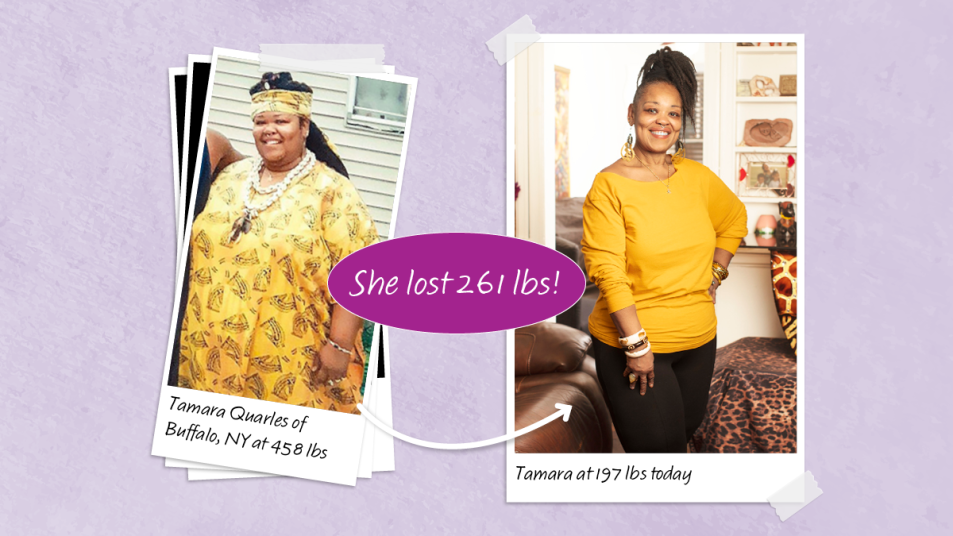
We can’t be the only ones who love creamy foods that stay mixed together, like that ready-to-enjoy peanut butter we can dip our spoon into, no stirring required. But what if we told you the additives in creamy-smooth nut butters, yogurts, hummus, dairy-free milks and salad dressings are causing the number on the scale to climb? Yale- and Harvard-trained Dawn Harris Sherling, MD, asserts, “The very chemicals that extend our food’s shelf life are causing problems within our gut and beyond.” In short: Emulsifiers in food are causing us to gain weight. Here’s what you need to know to dodge the problem.
What are emulsifiers?
Emulsifiers are a type of nonfood additive put in all sorts of processed foods. They began appearing in grocery items decades ago — and with scant testing — to improve food’s texture by preventing oil and water from separating. (Emulsifiers are also used in laundry detergent to help water infiltrate greasy stains.) Now that more sophisticated testing exists, experts are sounding the alarm about the health and weight ramifications of these add-ins, which are found in nearly all processed and packaged foods. In fact, estimates suggest that 57% of a standard American diet is comprised of these types of ultra-processed foods. Dr. Sherling, author of Eat Everything, says, “A typical meal can contain a half dozen emulsifiers and additives.”
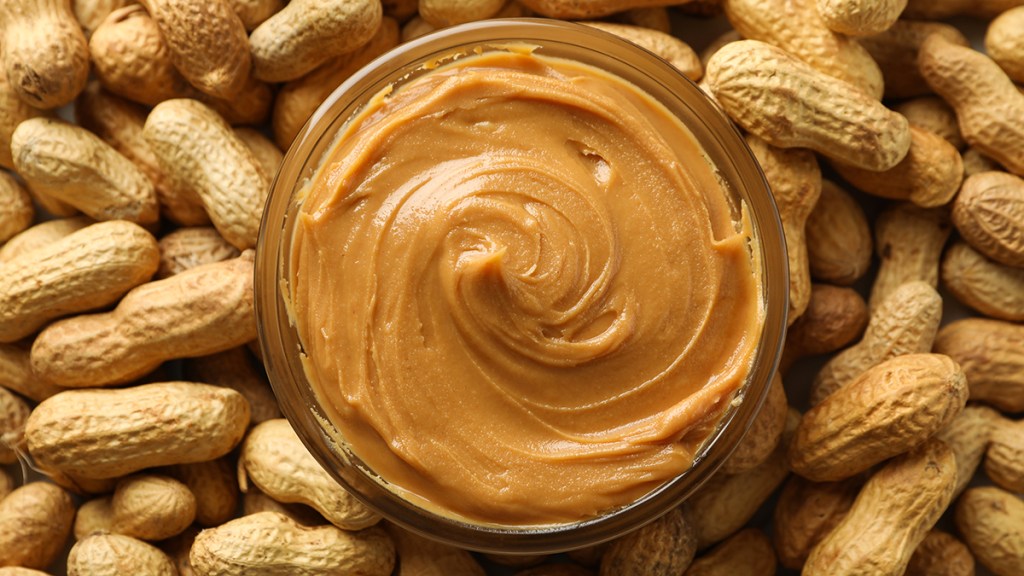
And while it’s easy to look at a cake or cookie and know it isn’t 100% healthy, emulsifiers lurk in surprisingly healthy foods too. They’re lurking in protein bars, premade smoothies and almond milks that proclaim “all natural” and “organic” on their packaging. Dr. Sherling has been caught in this trap herself, recalling how she once ordered an oat milk latte at a coffee shop, thinking it was a healthier option, only to discover she was drinking a mug of chemicals. “What’s frustrating is so many women are trying to do the right thing by eating healthy foods, but it’s changing their gut microbiome for the worse,” says Dr. Sherling. “We are being sabotaged!”
Emulsifiers damage our gut, leading to weight gain
Manufacturers use emulsifiers to keep food looking its best on shelves, but once ingested, they are anything but pretty for our health. Emulsifiers strip away the gut’s protective lining. In this weakened state and overwhelmed by constant foreign substances, the gut can lose its ability to keep harmful microbes and undigested food contained. As a result, those toxins “leak” into the bloodstream, triggering inflammation and illness.
David Brownstein, MD, an expert on this phenomenon, known as leaky gut syndrome, asserts that food additives are a big reason gut problems occur “in the vast majority of our population.” Indeed, experts estimate that 80% of women over 50 suffer from leaky gut. That’s a problem for our waistlines: In a study published in the journal Obesity, women with the most inflamed, “leaky” guts developed 132% more belly fat than their peers with the least damaged guts.
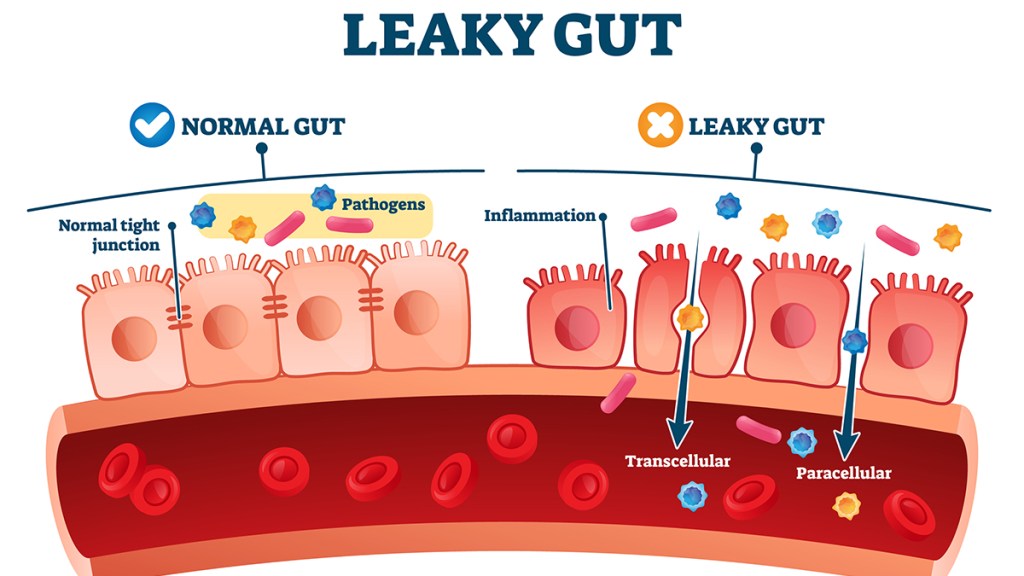
“Our body is not a temple; it is a garden,” says Dr. Sherling. She warns that packaged foods loaded with chemical additives like emulsifiers — often with confusing scientific names — are making “bad” bacteria in our gut grow like weeds. The result? Inflammation and GI symptoms.
Emulsifiers drive cravings
Gut damage isn’t the only way food emulsifiers affect our metabolism and make us gain weight. Foods loaded with emulsifiers also compel us to overeat. Dr. Brownstein says, “The problem is that emulsifiers make food feel good in our mouth so we want to eat more.”
World-famous Penn State researcher Barbara Rolls, PhD, agrees. She knows that the way food feels in the mouth can dramatically impact our appetite. (Click through to learn about her ‘Volumetrics’ weight-loss plan). She says, “There’s a lot of research now on the viscosity and texture of food leading us to eat more.” It’s true, foods with a rich, creamy texture taste more appealing on our palates.
Eric Westman, MD, author of End Your Carb Confusion, adds, “Entire industries are dedicated to studying the texture profiles that make you want to eat more.” That’s maddening since Dr. Sherling explains, “These additives provide no calories for us, but are a massive food source for our bad gut bacteria.”
And that’s not all: Food containing emulsifiers also disrupt our appetite-curbing hunger cues. That may explain why, in a Cell Metabolism study, people given emulsifier-laden food ate 500 more calories per day and gained 2.2 pounds over two weeks than folks given whole foods containing equal calories. And in an animal study, mice that were fed these emulsifiers developed metabolic syndrome and had a 142% increase in body fat.
How to outsmart emulsifiers — and weight gain
Step 1: Avoid the worst offenders
Although food emulsifiers are all around, threatening weight and health, it’s possible to protect yourself against the harm. The first step is to read food labels, says Dr. Sherling.You’ll want to avoid these top offenders:
Carrageenan: “I put carrageenan really high on the list of emulsifiers to avoid,” says Dr. Sherling. Carrageenan, used as a thickener in many dairy and nondairy products, is associated with inflammatory bowel disease. In fact, Dr. Sherling notes that scientists use carrageenan “on purpose” to cause inflammation in lab mice for studies. So we don’t want it anywhere near our body. And surprisingly, this harmful ingredient can still appear in certified organic grocery products because it is derived from ultra-processed red seaweed plants.
Chemical gums: There are several additive gums to avoid. Cellulose gum (or methylcellulose), is often found in shredded cheese, to prevent the product from clumping. Even popular plant-based meats contain fillers like cellulose gum, which can harm the gut and have a laxative effect. (A safer bet: Hilary’s Organic World’s Best Veggie Burgers.)
Also be on the lookout for any type of “gum” additive in nondairy ice cream. Without milk fat to hold ingredients together, brands often use additives like locust bean gum, xanthan gum or gellan gum. Dr. Sherling says a safer bet for dessert would be a frozen sorbet.
Polysorbate: This additive is used in baked goods and yogurt. The worst offender is known as polysorbate 80. Clean brands of yogurt contain only milk and live, active cultures. So sidestep ones loaded with fake sugars, like maltodextrin, and thickeners, including soy lecithin. One to try: Fage Total 0% Greek Yogurt.
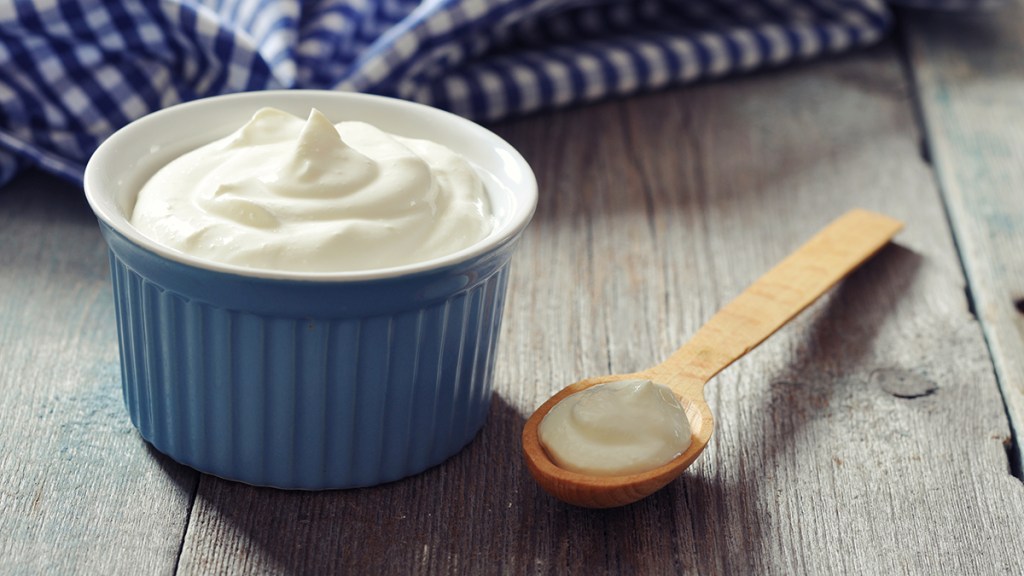
Step 2: Eat whole foods whenever possible
One of the easiest ways to avoid emulsifiers is to opt for whole foods that provide the raw materials (fiber, vitamins, minerals) to satisfy hunger, says Dr. Sherling. Her four-week plan is helping women heal and slim. “Eat all the foods you enjoy,” she says, “but they should be real foods whenever possible.”
Dr. Sherling promises, as soon as you begin to reach for more whole foods and cut back on processed foods, you’ll start to see and feel the difference. She says, “If you’re struggling with GI problems, your blood sugar or your weight, I’m here to say you can eat everything—as long as most of it is real food, unadulterated by gut-roiling additives.”
And Dr. Sherling certainly doesn’t want to be the food police. She named her book “Eat Everything” because she truly doesn’t want people to think they have to cut out entire food groups or deprive themselves of foods they love. Instead, Dr. Sherling’s approach is to simply make the best, informed decisions you can with the options that are available. For example, knowing that most milk alternatives contain stabilizers and making homemade nut milk may not fit into everyone’s busy lifestyle, simply opt for a safer pre-made version, like Malk Organic Almond milk.
Best of all, if you make these healthy tweaks now to reduce your emulsifier intake, you’ll experience speedy gut healing and slimming, so you can confidently enjoy more foods in the future without fear of pain or weight gain.
How avoiding emulsifiers helps overall health
And losing weight is just one perk of reducing your emulsifier intake. Hanan Mitry, 51, relieved major pain and digestive trouble by following Dr. Sherling’s advice to cut out emulsifiers and additives. Plus Dr. Sherling erased her own chronic IBS symptoms in one day after avoiding additives. She says, “You’re going to feel an improvement in energy, pain and mental clarity — it’s not subtle.” She’s also seen diabetes patients drop their blood-sugar readings by 200 points and A1C numbers by 6 points in three months. Why so fast? “The bacteria in our gut reproduce at such a rapid rate that what you eat today affects the gut tremendously tomorrow.”
A 4-week eating plan to get you started
To experience the healing and weight-loss results of cutting out food emulsifiers yourself, follow Dr. Sherling’s plan for the next four weeks.
Week 1: Start by eating more whole foods and avoiding three of the worst emulsifier additives: carrageenan, polysorbate 60 or 80 and cellulose gum (also called carboxymethylcellulose). Become a diet detective and check the labels for unfamiliar terms, especially when buying seemingly healthy (often expensive) packaged foods. When given the option, reach for homemade baked goods over store-bought options that contain fillers meant to lengthen their shelf life. And when no perfect option is in sight, Dr. Sherling’s motto is, “Choose the ‘least bad’ option.”
Weeks 2 to 4: Continue removing more unnatural additives from your diet, like the artificial sugar maltodextrin and food dyes such as red 40. Although our bodies have a tolerance for some level of synthetic substances in our diet, Dr. Brownstein, author of Heal Your Leaky Gut, says, “We have to expend energy to rid each nonfood item. And if they add up, they wreak havoc on our health and ability to lose weight.” Remember: The goal isn’t perfection. You simply want to reduce your toxic load.
Throughout the month, fold in these bonus tips to turbocharge gut healing and weight-loss even more…
Embrace ‘ugly’ foods. “When eating healthier, it’s okay for things to look like they are in their natural state,” assures Dr. Sherling. That means opting for clumpy yogurt, need-to-shake almond milk, even misshapen fruits and vegetables. “It would be good for our health to give up some of the aesthetics and get used to uglier looking food.”
Use this code at restaurants. “I’ve found that some chain restaurants note which items on their menus are Paleo- or Whole30-friendly,” says Dr. Sherling. “These terms tend to be shorthand for avoiding foods with additives.”
Whip up homemade sauces. Rather than buying processed bottled marinades or sauces, Dr. Sherling advises making them from scratch. Her advice? “The key is to pair an acid with a fat and throw in some spices.” Her favorites, which are easy to toss together: lemon juice, olive oil, plus salt, pepper and garlic or lime, sesame oil and soy sauce.
Look closely at ‘white’ treats. A chemical additive called titanium dioxide is used to make foods like marshmallows and frosting appear ultra-white. But studies suggest its particles can accumulate in the body to alter DNA and may even cause cancer. Dr. Sherling says, “If a treat you are about to eat has something blindingly white on it, pay particular attention to the label.”

Be smart with sweeteners. Unless you’re diabetic, Dr. Sherling suggests using real sugar or honey rather than artificial sweeteners that our digestive system doesn’t
recognize as food and that the World Health Organization recently advised against using.
Check nonfood labels too. Harmful emulsifiers and chemicals don’t just get into our body from food. For that reason, it’s a good idea to scan labels on medication, supplements, chewing gum, toothpaste and skincare products and opt for those without these additives.
It worked for Tamara: She lost 261 lbs!
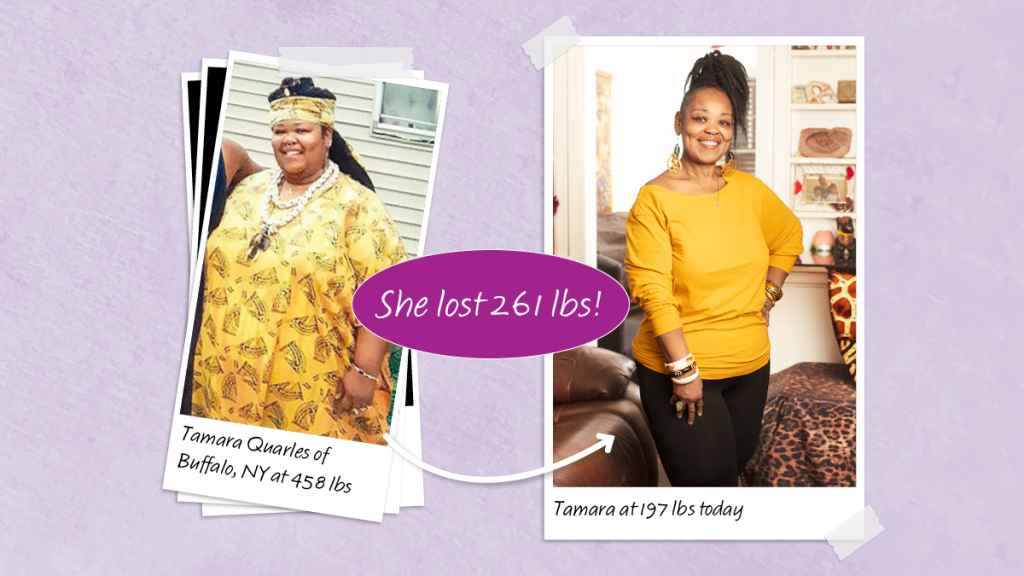
Tamara Quarles knew her stressful, sedentary job had taken a toll on her body over the years. But when she saw a photo from her family’s July 4th reunion cookout and didn’t even recognize herself, she knew it was time to face the extra 200 pounds she was carrying. I’ve been fighting with myself over food and only getting heavier, she thought. It’s time to regain control.
As a healthy kick start, Tamara tried juicing for 14 days, flooding her body with nutrients from unprocessed fruits and veggies. After that, she kept making changes, shunning packaged foods and cutting out chemical additives, like MSG, artificial sugars, food coloring and dyes. She says, “My rule became: If I didn’t prepare it myself, I considered it processed food.”
Instead of depriving herself, this busy grandmother used herbs and spices to boost flavor. She also added whole-food ingredients to egg dishes, sprinkling in tomatoes or mangoes — ”anything but the kitchen sink.” She found her hunger was more sated on “real” comfort meals than the old fakes.
Tamara was thrilled to find she dropped 20 pounds the first week and continued to optimize her metabolism and digestion by focusing on eating clean foods. She had more energy and felt steadier and less wobbly on her feet. Through it all, she says she never dieted. “The word ‘diet’ has never been in my vocabulary.”
Today, Tamara is more than 250 pounds lighter and is confident she’s extended her longevity. “I want to live to 120 with all my God-given senses.” Best of all, she’s overjoyed to have maintained her weight loss for four years. “I defeated the biggest giant: obesity,” cheers the TOPS Club member. “It’s a balance, but I reclaimed myself mentally, emotionally, physically and spiritually!”
To learn more, check out these other articles about unhealthy chemicals in foods:
How to Eliminate GMOs From Your Diet For Weight Loss and Optimal Health
This Common Ingredient in Over 1,200 Popular Snack Foods May Be Weakening Your Immune System
This article originally appeared in our print magazine, First For Women.
This content is not a substitute for professional medical advice or diagnosis. Always consult your physician before pursuing any treatment plan.

Lisa Maxbauer is an award-winning health and nutrition writer at First for Women and Woman’s World magazines. She is a former guest blogger with The New York Times and author of the award-winning independent children’s book Squash Boom Beet. Learn more at SquashBoomBeet.com and follow on Instagram @lisamaxbauer.
















